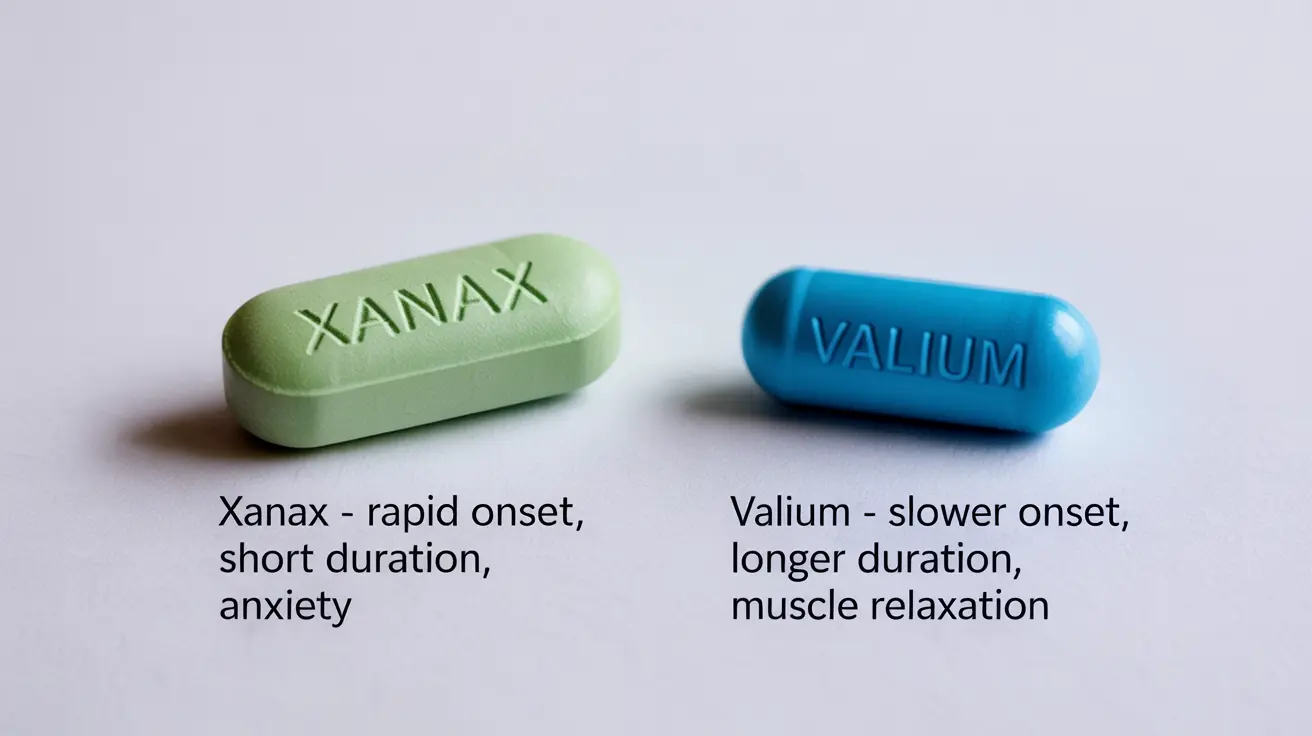Understanding the differences between Xanax and Valium is crucial for anyone considering or currently taking these medications for anxiety disorders. Both belong to the benzodiazepine class of drugs but have distinct characteristics that make them suitable for different situations and patients.
This comprehensive guide explores the key differences between these commonly prescribed anti-anxiety medications, including their effects, uses, and potential risks. Understanding these distinctions can help inform discussions with healthcare providers about treatment options.
Chemical Properties and Basic Differences
Xanax (alprazolam) and Valium (diazepam) work by enhancing the effects of GABA, a natural chemical in the brain that promotes calmness. However, their chemical structures result in different properties and effects on the body.
Xanax is known for its more potent and immediate impact, while Valium typically has a gentler onset but longer-lasting effects. These characteristics influence how doctors prescribe these medications for different conditions and situations.
Onset and Duration of Effects
Xanax typically begins working within 15-30 minutes, with peak effects occurring within 1-2 hours. Its effects generally last 4-6 hours, making it particularly useful for acute anxiety attacks.
Valium, conversely, takes effect within 15-60 minutes but can last significantly longer, often 20-100 hours. This extended duration makes it more suitable for managing chronic anxiety conditions and providing longer-term relief.
Primary Uses and Applications
Xanax Applications
Xanax is primarily prescribed for:
- Panic disorders
- Acute anxiety attacks
- Social anxiety disorder
- Short-term anxiety relief
Valium Applications
Valium has a broader range of applications:
- General anxiety disorder
- Muscle spasms
- Seizure disorders
- Alcohol withdrawal
- Pre-surgery sedation
Side Effects and Safety Considerations
Both medications can cause similar side effects, but their intensity and duration may differ. Common side effects include:
- Drowsiness
- Dizziness
- Confusion
- Coordination problems
- Memory issues
Valium's longer half-life typically results in more gradual side effects, while Xanax's effects may be more pronounced but shorter-lasting.
Risk of Dependence and Withdrawal
Both medications carry risks of physical and psychological dependence, but their patterns differ. Xanax typically has a higher risk of developing dependence due to its shorter duration and more intense effects, often leading to more frequent dosing.
Withdrawal from Valium tends to be more gradual due to its longer half-life, potentially making it easier to taper off under medical supervision. However, both medications require careful monitoring and proper discontinuation protocols.
Frequently Asked Questions
What are the main differences between Xanax and Valium in treating anxiety disorders?
Xanax works more quickly and is better suited for acute anxiety and panic attacks, while Valium has a longer duration of action and is often prescribed for chronic anxiety conditions. Xanax's effects are typically more intense but shorter-lasting compared to Valium.
How do the onset and duration of effects compare between Xanax and Valium?
Xanax takes effect within 15-30 minutes and lasts 4-6 hours, while Valium begins working within 15-60 minutes and can last 20-100 hours. This makes Valium more suitable for long-term anxiety management.
What are the risks and side effects associated with taking Xanax versus Valium?
Both medications can cause drowsiness, dizziness, and coordination problems. Xanax typically has more intense immediate side effects, while Valium's side effects may be milder but longer-lasting. Both carry risks of dependence and require careful medical supervision.
Can Valium be used for conditions other than anxiety, and how does that differ from Xanax?
Yes, Valium has more diverse applications including muscle spasms, seizure disorders, and alcohol withdrawal management. Xanax is primarily used for anxiety and panic disorders, making it more specialized in its applications.
Is there a higher risk of dependence or withdrawal symptoms with Xanax compared to Valium?
Yes, Xanax generally carries a higher risk of dependence due to its shorter duration and more intense effects, often requiring more frequent dosing. Withdrawal from Xanax can be more challenging compared to Valium, which typically allows for a more gradual tapering process.




